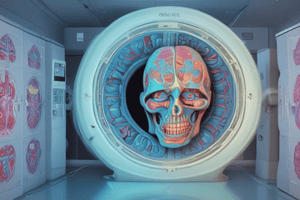Podcast
Questions and Answers
What is the purpose of interpolation in the context of image reconstruction during helical CT?
What is the purpose of interpolation in the context of image reconstruction during helical CT?
- To eliminate data points for better clarity
- To estimate values within known values for more accurate images (correct)
- To transform data from helical to circular motion without estimation
- To collect data points exclusively from the center of the volume
What distinguishes interpolation from extrapolation in image reconstruction?
What distinguishes interpolation from extrapolation in image reconstruction?
- Extrapolation estimates values outside the known range of data (correct)
- Extrapolation estimates values within known values
- Interpolation deals only with complete data sets
- Interpolation estimates values beyond known data limits
Which statement accurately describes the function of interpolation algorithms in CT imaging?
Which statement accurately describes the function of interpolation algorithms in CT imaging?
- They perform a weighted average of data across multiple projection angles (correct)
- They process data solely from projections taken at right angles
- They generate isotropic volume images without interpolation
- They reconstruct images without the need for any pre-existing data
What challenge does helical CT scanning present in regard to data acquisition?
What challenge does helical CT scanning present in regard to data acquisition?
How do contemporary CT reconstruction algorithms differ in their assumptions about x-ray source movement?
How do contemporary CT reconstruction algorithms differ in their assumptions about x-ray source movement?
Flashcards
Interpolation
Interpolation
Mathematical process used to estimate unknown values between known values, often applied to reconstruct images in CT scans.
Helical CT
Helical CT
A type of CT scan where the x-ray source moves in a helical path around the patient, acquiring data continuously.
Interpolation Algorithm
Interpolation Algorithm
Computer program that uses interpolation to create a smooth transition between known data points, especially in CT image reconstruction.
Isotropic Volume Image
Isotropic Volume Image
Signup and view all the flashcards
Data Interpolation in Helical CT
Data Interpolation in Helical CT
Signup and view all the flashcards
Study Notes
Image Reconstruction in CT Scans
- Image reconstruction at any z-axis position is possible using interpolation, a mathematical process.
- Interpolation estimates values between known data points, while extrapolation estimates beyond known ranges.
- Helical CT acquires data continuously, but the reconstruction plane lacks sufficient data for direct reconstruction.
- Interpolation algorithms, special computer programs, estimate missing data.
- Interpolation creates new slices between existing slices to generate isotropic volume images (meaning equal resolution in all directions).
- Helical CT scans use a helical trajectory for X-ray source movement, unlike conventional circular paths.
- Conventional reconstruction methods cannot handle this helical data directly.
- Before reconstruction, helical data are interpolated into planar sets, using weighted averages of data from neighboring projections at different angles..
- Interpolation algorithms are essential for reconstructing axial images from helical data.
Studying That Suits You
Use AI to generate personalized quizzes and flashcards to suit your learning preferences.




